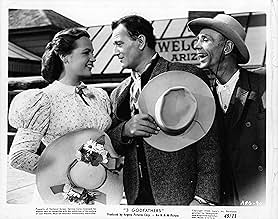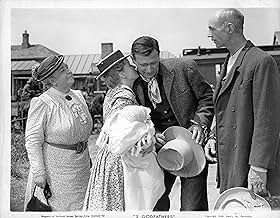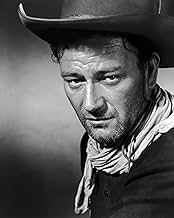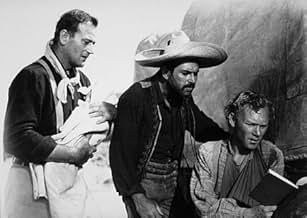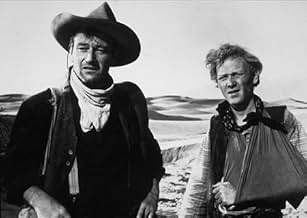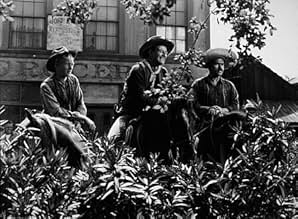NOTE IMDb
7,0/10
11 k
MA NOTE
Lorsque trois hors-la-loi en cavale rencontrent dans le désert une femme mourante et son nouveau-né, ils jurent de sauver l'enfant.Lorsque trois hors-la-loi en cavale rencontrent dans le désert une femme mourante et son nouveau-né, ils jurent de sauver l'enfant.Lorsque trois hors-la-loi en cavale rencontrent dans le désert une femme mourante et son nouveau-né, ils jurent de sauver l'enfant.
- Réalisation
- Scénario
- Casting principal
Pedro Armendáriz
- Pedro Roca Fuerte
- (as Pedro Armendariz)
Gertrude Astor
- Saloon Girl
- (non crédité)
Nora Bush
- Townswoman
- (non crédité)
Avis à la une
Redemption is the keyword to many a Ford work:this is perhaps the most convincing effort in a remarkable career for that matter.Like all the great auteurs,western is only an alibi for Ford to convey a message:God is the only way,the Bible is the only book for Man's education (as Dr Whatsisname's infant care manual for the new human being).
If you do not know anything about the screenplay and you expect a traditional western ,you may be disappointed:actually it might as well be a Xmas tale.Actually ,only the beginning and the ending are what you expect from a western.The central part is Robert's (Wayne) road to Damascus.His two pals do believe in God,he doesn't.The desert and the quest of water are a metaphor for the emptiness of his heart.In the second part of the movie,he's like the baby,busy being born.
Ford's movie is a visual splendor:the three men filmed against the sunlight near the mother's grave;the grave shot in close-up as the three men go away.The desert itself becomes an almost alive entity,filmed with a unique sense of space .Narration avoids readiness:when Wayne meets the mother,Ford does not show the scene:he lets his character tell it to his friends.The mother briefly appears for one short scene but she makes all her words count.
Singing is very important:when the mother is buried ,William sings over his grave but he cannot finish his canticle because he cannot remember the end:thus Ford avoids pathos and melodrama;when he rocks the baby,he sings "streets of Laredo",an ominous choice(but lullabies are sometimes strange and even cruel,aren't they?);the final choir "bringing in the sheaves" signals a brand new life for Robert. Towards the end ,the movie verges on fantastic ,which is extremely rare in the western genre.
Biblical quotations abound,but anyway,they are everywhere in Ford's work from the earlier works (the informer) to the later ones (seven women).
In the eighties,Coline Serreau made a shameless rip -off "trois hommes et un couffin".It wasn't a western ,the action taking place in Paris 1985,but a lot of ideas were taken from Ford .Besides,her three characters were despicable machos:One wishes it had not come from a woman .The movie was such a huge success that the American felt compelled to redo it (three men and a baby).Forget these mediocrities and do watch the Master 's tale of redemption.
If you do not know anything about the screenplay and you expect a traditional western ,you may be disappointed:actually it might as well be a Xmas tale.Actually ,only the beginning and the ending are what you expect from a western.The central part is Robert's (Wayne) road to Damascus.His two pals do believe in God,he doesn't.The desert and the quest of water are a metaphor for the emptiness of his heart.In the second part of the movie,he's like the baby,busy being born.
Ford's movie is a visual splendor:the three men filmed against the sunlight near the mother's grave;the grave shot in close-up as the three men go away.The desert itself becomes an almost alive entity,filmed with a unique sense of space .Narration avoids readiness:when Wayne meets the mother,Ford does not show the scene:he lets his character tell it to his friends.The mother briefly appears for one short scene but she makes all her words count.
Singing is very important:when the mother is buried ,William sings over his grave but he cannot finish his canticle because he cannot remember the end:thus Ford avoids pathos and melodrama;when he rocks the baby,he sings "streets of Laredo",an ominous choice(but lullabies are sometimes strange and even cruel,aren't they?);the final choir "bringing in the sheaves" signals a brand new life for Robert. Towards the end ,the movie verges on fantastic ,which is extremely rare in the western genre.
Biblical quotations abound,but anyway,they are everywhere in Ford's work from the earlier works (the informer) to the later ones (seven women).
In the eighties,Coline Serreau made a shameless rip -off "trois hommes et un couffin".It wasn't a western ,the action taking place in Paris 1985,but a lot of ideas were taken from Ford .Besides,her three characters were despicable machos:One wishes it had not come from a woman .The movie was such a huge success that the American felt compelled to redo it (three men and a baby).Forget these mediocrities and do watch the Master 's tale of redemption.
I'm surprised this one doesn't get more accolades. To me it's really one of the best westerns ever made. This is one of those films that proves that the western genre can produce true art. The filming, the performances -- this is one of Wayne's best
it's quite overlooked that this guy could act: The desperation, the confusion, the exhaustion, it's all just amazing.
It's more of a character study than anything else, with the characters facing desperate thirst, an aching empty land, relentless sun, and the movie shows how these men deal with it, all the while they are attempting to care for a child. Something they are ill equipped to do.
There are clear religious elements to the movie, and they make this all the more compelling -- these are not good men, but they have a sense of honor and faith, in their own way. They can't break their word to a dying woman, to care for her child. Their faith in each other is touching.
It's gritty, yet very tender, a strange juxtaposition, like the beauty and cruelty of the desert.
See the movie if you can.
It's more of a character study than anything else, with the characters facing desperate thirst, an aching empty land, relentless sun, and the movie shows how these men deal with it, all the while they are attempting to care for a child. Something they are ill equipped to do.
There are clear religious elements to the movie, and they make this all the more compelling -- these are not good men, but they have a sense of honor and faith, in their own way. They can't break their word to a dying woman, to care for her child. Their faith in each other is touching.
It's gritty, yet very tender, a strange juxtaposition, like the beauty and cruelty of the desert.
See the movie if you can.
A really touching, naive, heart-warming Christmas movie, even if it may be quite a tear-jerker, especially at it's end: great cinematography - watch out for the wonderful impressions of the desert (the director of cinematography started with documentaries) -, great direction and one of John Wayne's best performances - this man was not only a big star, he was a wonderful actor, too!!! Between the end of the forties and the end of the fifties Ford knew how to lead Wayne to an artistic peak. And, not to forget of course: Hank Worden, Ben Johnson, Ward Bond, Pedro Armendariz, Harry Carey jr, ... what an ensemble did Ford build up around himself!!! Highly recommended to all those who want their hearts to be touched in rough times during a cold winter evening ...
I can't say much for the storyline of 3 Godfathers as much as I can say for its visuals and imagery. For many, it is an allegorical tale with its heavy use of the Bible and other symbols throughout. However, I had a problem with the realism of the story, something this kind of plot needs to rely heavily on. Here we have three rough and tough men, by no means weak or unable to take care of themselves. Still, what they go through in this film along with trying to take care of a newly born infant, it boggles my mind as to how it is possible and perhaps it isn't.
I think I am reading too much into this and am missing the point John Ford was trying to make. So, I will try to understand the movie in its simplest terms. That would be that Ford was a master of imagery and using it to further the story. Here, every shot of the desert and swirling winds captures perfectly the atmosphere and mood, making the audience feel as if they are in the desert. It is most effective and does pick up some of the slack such as when the three men are first taking care of the infant or the final ten minutes in deciding Wayne's fate. All in all, this is not one of the great Ford Westerns. But, it shows once again his ability to control the mood and tone of his films and that can go a long way in providing leverage to an audience.
I think I am reading too much into this and am missing the point John Ford was trying to make. So, I will try to understand the movie in its simplest terms. That would be that Ford was a master of imagery and using it to further the story. Here, every shot of the desert and swirling winds captures perfectly the atmosphere and mood, making the audience feel as if they are in the desert. It is most effective and does pick up some of the slack such as when the three men are first taking care of the infant or the final ten minutes in deciding Wayne's fate. All in all, this is not one of the great Ford Westerns. But, it shows once again his ability to control the mood and tone of his films and that can go a long way in providing leverage to an audience.
Nice to watch this hoary old (Christmas) chestnut at Yuletide, almost exactly 60 years after its original release. And yes, while it is guilty of a number of sins by way of corniness, improbability and sentimentality, it still works for me and proves you don't need tinsel and snow to evoke the Christmas spirit. Here old Papa Ford relates his Christmas parable against the background of the searing heat of the Arizona desert as Duke Wayne struggles against the odds to deliver orphan child Robert William Pedro to safety, bang on, wouldn't you know it, Christmas Day. All the usual Ford staples are here, the panoramic scenery, male camaraderie, bawdy humour and of course big John Wayne himself in yet another barnstorming lead role. I'm not the biggest Wayne fan going, but Ford invariably got the best out of the big lunk and he certainly carries the film (and the baby!) manfully. His two confederates, the youthful Harry Carey Jr and TexMex Pedro Armendariz both of whom sadly expire along the way, offer effective and humorous counterpoint to big John's proselytising. Ford cleverly doesn't reveal his hand too quickly with only the odd Biblical reference alluded to early on but by the time the three amigos are spotlit gazing out at the camera having just accepted the dying mother's infant child into their care, it piles on from there. Along the way the humour and sentimentality are mixed up lightly with a little (not too much) dramatic tension as Wayne completes his epic journey (like he was ever going to fail!), spurred on by the ghosts of his fallen colleagues and completes his own spiritual regeneration in accepting with good grace his jail sentence at the end in exchange for a guarantee that he'll be reunited with his infant charge once his sentence is complete. Noting that the film is Ford's own remake of his earlier silent movie production of the same story would help explain why some of the scenes are somewhat static and staged tableau-style. Wayne gets to walk more than he talks, no bad thing, and the rest of the cast are all at home under the director's loving eye. All told, then a colourful (check the blue filter shot Ford employs to evoke the desert at night) and festive treat. But surely this child wasn't the Son of God...?!
Le saviez-vous
- AnecdotesJohn Wayne was badly sunburned while filming this movie and was briefly hospitalized.
- GaffesShortly after the three riders enter the desert Hightower discovers that Pedro's water bag is empty and throws it away. As they ride away in a long shot, the water bag is still visible on Pedro's horse.
- Citations
Pedro "Pete' Roca Fuerte: [dying] Hey, Bob... I just remembered what tomorrow is. Feliz Navidad.
- Bandes originalesBeautiful River (Shall We Gather at the River)
(uncredited)
Written by Robert Lowry and Charles Ives
Performed by Harry Carey Jr.
Meilleurs choix
Connectez-vous pour évaluer et suivre la liste de favoris afin de recevoir des recommandations personnalisées
- How long is 3 Godfathers?Alimenté par Alexa
Détails
Box-office
- Budget
- 1 243 000 $US (estimé)
- Durée
- 1h 46min(106 min)
- Rapport de forme
- 1.37 : 1
Contribuer à cette page
Suggérer une modification ou ajouter du contenu manquant


